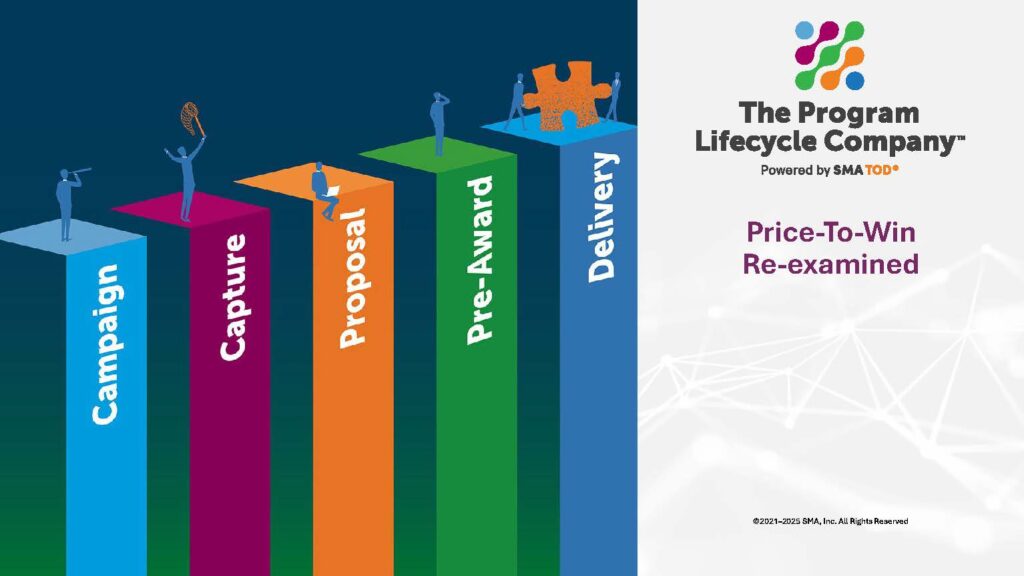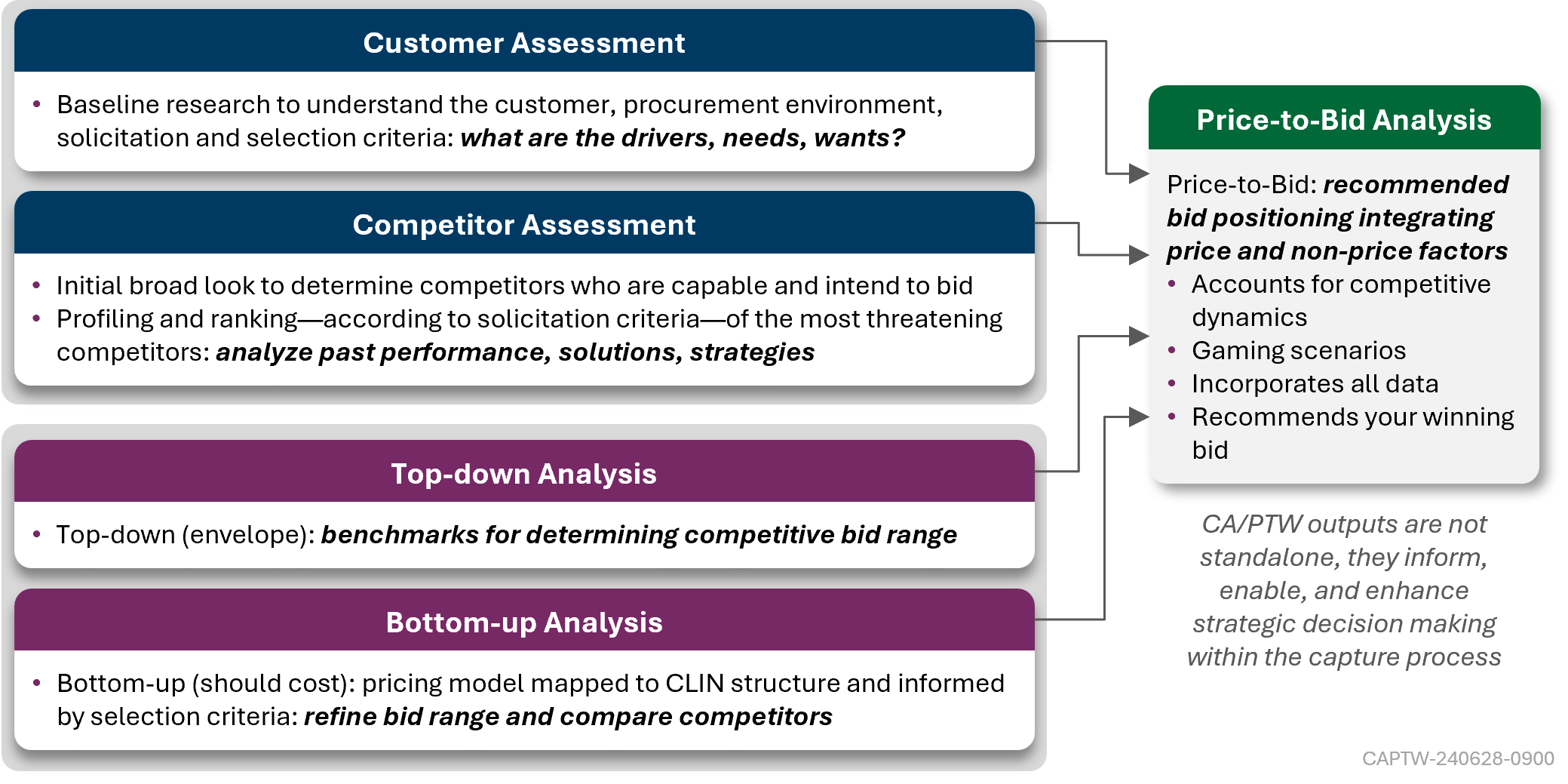Competitive Assessment & Price to Win (CA/PTW)
Our proven approach to CA/PTW combines analysis with subject matter expertise, bringing together an understanding of the customer and acquisition environment with a detailed analysis of relevant competitors, and Price to Win (PTW) analysis factoring quantitative and qualitative insights.
Competitive Assessment
Customer Assessment
We research your customer and develop a clear view of their organization, portfolio, decision process, buying behavior, award patterns, and any indicators of biases. This analysis develops a set of most important requirements (MIRs), and a view of how your customer views the target program and how it fits into their portfolio. We take a holistic approach, incorporating insights from open source data, industry experts, and former government and military leaders.Deep-Dive Competitor Profile
We perform a deep dive analysis of your selected competitors, providing you with insights about their strengths, weaknesses, bid intent, technical solutions, past performance qualifications, teaming strategy, business unit and corporate performance, and any other factors that may impact their bid strategies. These qualitative findings serve as the foundation for our estimated competitor bid price. We develop an overview of each of the competitors’ likely solutions/offerings and the associated risks and rewards of their approaches, including technical and management approach, value proposition, strategic intent, and win strategy.Competitor Behaviors
We analyze previous bid approaches for similar programs pursued by your competitors to develop an understanding of their previous bid behavior. The assessment can include:- Relative significance of the target program: We evaluate the significance of the program to the business unit and the corporation as a whole, including rough estimates of financial and strategic impact for the organization.
- Historic “bid approaches”: We perform case studies on “similar to” programs focused on identifying approaches that can be reused for the target program.
- Shaping behavior: We analyze competitors’ approaches and impact on shaping program requirements across the stakeholder community.
- “Game Changers”: We evaluate innovations that can be leveraged to strengthen the competitors’ technical or price position.
Price to Win Analysis
Top-Down Analysis
We research the customer’s budget to determine a ceiling and budget available to the contractor for target program. We then research bid trends and perform a bid-to-budget analysis for each of the selected competitors. This analysis establishes a historic bid range as a percentage of the available budget, based on past bidding behavior.Customer Funding Analysis
We estimate the contractor-addressable portion of the target program funding based on an analysis of the budget, adjusted based on customer insight such as budget reduction metrics:- Total budget, top down
- Less PMO, and other government hold-backs based on similar programs
- Net addressable contractor budget
- Less cost reduction targets
Should Cost Analysis
We begin the cost analysis with the program’s “should cost” from the perspective of the customer, and develop a detailed “should cost” model, similar to our existing high-level framework shown in the figure. In addition to the detailed modeling, we use a combination of top-down estimating, “similar to” parametrics, and technology and commercialization trends.| Cost Model |
|---|
| Labor resources & direct costs (recurring), including hours & rates, support labor, management & engineering, and expected productivity |
| Non-recurring expenditure (NRE) range* |
| Facilities |
| Other Direct Costs |
| Indirect costs: fringe, overhead, G&A, etc. |
| FCCM and Fee |
* Note: we estimate NRE as a range
We work with our Subject Matter Experts to develop and apply Cost Estimating Relationships (CERs) for each element of cost for target program. We use these CERs to develop both the material and labor costs for each element of cost, and tailor to account for the target program requirements. Approaching this from the customer’s “should cost” estimation standpoint, we take a high-level approach to determine the expected cost of producing the target program not only by the competitors, but also by your team. This more accurately reflects the customer’s “should cost” position going into the competition, the understanding being that one competitor’s cost to build the target program may be lower than that of their competitors’, while the other might be higher. For each competitor, we consider the costs associated with a range of factors that might apply based on its familiarity with building similar programs.
Bottom-Up Analysis
We develop a detailed buildup for the selected competitors. Our estimates take into account the cost of hardware, engineering, software, and installation. We present our analysis in the same format requested in the target program Request for Proposal (RFP) or another format at your request.We perform a full-burdened labor rate analysis for the selected competitors. The labor rates analysis provides details that include the competitors’ likely salary, fringe, overhead, G&A, and fee/profit. We use our established methodology for developing the rates. The labor rates analysis summarizes the cost components of the competitors’ rate structure such as 401(k) plans and participation, health benefits, paid time off (PTO), etc. Our findings inform you on the competitiveness of your direct and indirect rates structures.
Price to Win Recommendation
Combining our program analysis (evaluation criteria, weighting, willingness to pay for a premium offering, etc.), competition analysis, and competitor cost analysis, we develop a perspective on the strategic intent, areas for gaming, and cost reductions for the competition. We reflect these non-price factors in our estimate and provide a range of possible bids for each competitor. We can then recommend a PTW to you based on our understanding of your relative competitive positioning. We also take known, but undocumented customer needs and run permutations of our PTW to identify their potential impact to your win probability.Solutions and Downloads

CA/PTW Assessment
Take this assessment to check your implementation and execution of CA/PTW on proposal efforts, and start the journey to improve your internal processes.
Black Hat Review
Using the CA results, our Black Hat approach maximizes skills and experience of review attendees, while driving toward actionable findings for the capture team.
